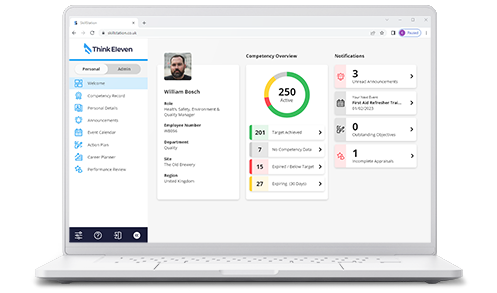In today's fast-paced business environment, cultivating a skilled and engaged workforce is paramount. Join us as we explore the power of competency management in driving employee development, engagement, and organisational success.
Introduction
In the words of former Apple CEO, Steve Jobs, "A small team of A players can run circles around a giant team of B and C players." What distinguishes these "A players" – the exceptional individuals who drive organisational success? They possess not only the requisite skills and knowledge but also a profound alignment with the values and objectives of their organisation.
However, in today's fiercely competitive talent landscape, identifying and retaining these exceptional individuals poses a formidable challenge. Equally challenging is discerning the "B players”, those who may share the organisation's values but lack the necessary skills to reach "A player" status. And then there are the "C players" – individuals whose negative attitudes or toxic behaviours can undermine the very fabric of the organisation, impeding progress and eroding morale.
Addressing these challenges begins with clear leadership and a defined organisational vision. Leaders must collaborate with subject matter experts to delineate the skills and competencies essential for achieving organisational goals. This process culminates in the creation of a competency framework – a strategic tool that serves as the foundation for talent management and organisational development.
Understanding Competency Management
At its core, competency management is the systematic process of identifying, assessing, and developing the skills and knowledge required for individuals to perform effectively in their roles within an organisation. It encompasses a range of activities, including defining competencies, evaluating proficiency levels, and providing targeted development opportunities.
Key components of competency management include:
- Competency Identification: This involves identifying the specific skills, behaviours, and knowledge areas that are essential for success in various roles within the organisation. Competencies may vary depending on job function, department, or level of responsibility.
- Assessment and Proficiency Evaluation: Once competencies are identified, organisations assess the proficiency levels of employees in each competency area. This assessment may involve self-assessment, manager evaluations, or formal competency assessments.
- Development Planning: Based on the assessment results, development plans are created to address any skills gaps or areas for improvement. These plans may include training programs, coaching, mentoring, or on-the-job experiences designed to allow employees' meet allowed competency levels.
Now, why is competency management essential for organisational success?
Competency management plays a vital role in driving organisational success for several reasons:
Firstly, it ensures alignment between individual capabilities and organisational objectives. By defining the competencies required for success in each role, organisations can ensure that employees possess the skills needed to contribute effectively to the achievement of business goals.
Secondly, competency management enables organisations to identify and address skills gaps and development needs proactively. By regularly assessing employees' proficiency levels, organisations can identify areas where additional training or support is needed to enhance performance.
Lastly, competency management fosters a culture of continuous learning and improvement. By providing employees with opportunities to develop their skills and advance their careers, organisations can increase employee engagement, satisfaction, and retention.
A key tool in the competency management process is the competency framework. Competency frameworks provide a structured framework for defining and organising competencies within an organisation. These frameworks typically include a set of core competencies that apply across the organisation, as well as job-specific competencies tailored to individual roles.
Competency frameworks play a crucial role in guiding employee development and performance by providing clear expectations and standards for success. They help employees understand what is expected of them in their roles and provide a roadmap for skill development and career progression.
In summary, competency management is essential for organisational success because it ensures alignment between individual capabilities and organisational objectives, identifies and addresses skills gaps proactively, and fosters a culture of continuous learning and improvement. Competency frameworks play a key role in guiding employee development and performance by providing clear expectations and standards for success.
The Benefits of a Competency Management System
The benefits of a competency management system extend beyond the traditional HR functions. These systems offer several transformative advantages for organisations:
- Streamlined Talent Management: Competency management systems centralise employee data and competency profiles, facilitating more efficient talent acquisition, development, and retention processes.
- Data-Driven Decision-Making: By providing comprehensive insights into employees' skills and competencies, these systems enable data-driven decision-making regarding recruitment, training, succession planning, and performance management.
- Enhanced Employee Engagement: Competency management systems empower employees by offering visibility into their skill gaps and development opportunities. This transparency fosters a culture of ownership and continuous improvement, leading to higher levels of engagement and motivation.
- Improved Organisational Agility: With competency management systems, organisations can quickly adapt to changing business needs by identifying and addressing skills gaps in real-time. This agility is essential for staying competitive in today's dynamic marketplace.
Implementing a Competency Management System
While the benefits of competency management systems are clear, implementing them effectively requires careful planning and execution. Here are some key steps to consider:
- Define Clear Objectives: Before implementing a competency management system, clearly define your organisation's objectives and how the system will support them. Whether it's improving employee performance, reducing turnover, or enhancing organisational agility, having clear goals will guide the implementation process.
- Engage Stakeholders: Involve key stakeholders, including HR professionals, managers, and employees, in the implementation process. Their input and buy-in are essential for successful adoption and utilisation of the system.
- Select the Right System: Choose a competency management system that aligns with your organisation's needs, budget, and technical requirements. Consider factors such as user-friendliness, scalability, integration capabilities, and support. Look no further than SkillStation!
- Customise for Your Organisation: Tailor the competency management system to meet the unique needs and culture of your organisation. Customise assessment tools, and reporting features to ensure they align with your organisational goals and values.
- Provide Training and Support: Offer comprehensive training and support to employees who will be using the competency management system. Ensure they understand how to navigate the system, input data accurately, and utilise its features effectively.
- Monitor and Evaluate Performance: Continuously monitor the performance and usage of the competency management system. Solicit feedback from users and stakeholders to identify areas for improvement and make necessary adjustments.
By following these steps, organisations can maximise the benefits of competency management systems and drive positive outcomes for both employees and the organisation as a whole.
Driving Employee Development and Engagement
One of the primary benefits of competency management systems is their ability to drive employee development and engagement. These systems provide employees with visibility into their skills, strengths, and development areas, empowering them to take ownership of their professional growth.
With competency management systems, employees have access to personalised development plans tailored to their specific needs and career aspirations. These plans may include a combination of training programs, on-the-job experiences, mentoring, and coaching opportunities designed to enhance their competence and performance.
Moreover, competency management systems facilitate ongoing feedback and coaching conversations between managers and employees. By providing a structured framework for discussing performance and development goals, these systems promote a culture of continuous learning and improvement.
Employee engagement is also bolstered through increased transparency and visibility into career progression opportunities. A competency management system will enable employees to track their progress, identify areas for growth, and set meaningful development goals aligned with organisational objectives.
As a result, employees feel more engaged, motivated, and invested in their professional development journey. They understand how their contributions align with the organisation's goals and have the resources and support they need to succeed.
Overcoming Challenges and Pitfalls
While a competency management system will offer numerous benefits, they are not without challenges. Common pitfalls include:
- Resistance to Change: Implementing a competency management system may face resistance from employees who are accustomed to traditional performance management practices. To overcome this challenge, organisations must communicate the benefits of the system effectively and provide adequate training and support to users.
- Data Quality and Accuracy: Competency management systems rely on accurate and up-to-date data to be effective. Organisations must ensure that data input processes are standardised, and employees are trained to input data accurately to maintain data integrity.
- Integration with Existing Systems: Integrating a competency management system with existing HR systems and processes can be complex. Organisations must carefully plan and execute integration efforts to ensure seamless data flow and avoid duplication of efforts.
By addressing these challenges proactively, organisations can maximise the value of competency management systems and drive positive outcomes for employees and the organisation as a whole.
Looking Ahead: The Future of Competency Management
As technology continues to evolve, the future of competency management holds exciting possibilities. Advances in artificial intelligence (AI), machine learning, and data analytics are transforming how organisations identify, assess, and develop employee competencies.
AI-powered competency management systems can analyse vast amounts of employee data to identify patterns, trends, and correlations that may not be apparent to human observers. These systems could provide predictive insights into future skills requirements, enabling organisations to stay ahead of emerging trends and market shifts.
Furthermore, AI-driven personalised learning experiences can deliver targeted training content to employees based on their unique learning preferences, strengths, and development needs. This personalised approach to learning can enhance engagement and retention, leading to more effective skill acquisition and performance improvement.
Data analytics also play a crucial role in competency management, providing organisations with actionable insights into workforce capabilities, productivity levels, and performance trends. By leveraging these insights, organisations can make informed decisions regarding talent management, succession planning, and workforce optimisation.
To summerise, the future of competency management is bright, fuelled by advancements in technology and a growing recognition of the importance of talent development and optimisation. By embracing these innovations, organisations can position themselves for success in an increasingly competitive and dynamic business environment.
Conclusion
A competency management system is a powerful tool that can enable organisations to unlock the full potential of their workforce. By defining clear competencies, assessing employee proficiency levels, and providing targeted development opportunities, these systems drive employee development, engagement, and organisational performance.
When an organisation invests in competency management system, they will likely need to overcome challenges, embrace innovations, and adapt to evolving workforce dynamics. But by doing so, they can create a culture of excellence where employees thrive, and organisations achieve their goals and objectives.
The journey to excellence begins with competency management – are you ready to unlock the full potential of your workforce?
Try SkillStation FREE for 30 days!
Ready to take your organisation to the next level with competency management? Contact us today to learn how our competency management solutions can help you drive employee development, engagement, and organisational success.


